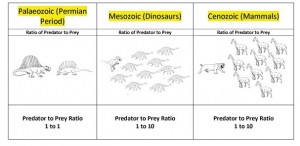Following up on the Endothermic versus Ectothermic Debate
Warm-blooded versus Cold-blooded Dinosaurs
Famous palaeontologist Dr Bob Bakker weighs into the cold-blooded versus warm-blooded dinosaur controversy.
Whilst writing up the recent article on a study of dinosaur locomotive capabilities we were reminded of some fascinating work undertaken by Dr Bob Bakker who took a novel approach to this particular aspect of palaeontology.
To read the recent article on Endothermy v Ectothermy: Debate over Warm-blooded Dinosaurs Hots Up.
Mammals and birds maintain a constant body temperature by producing body heat internally, (endotherms). Whereas, extant reptiles such as crocodiles and lizards have to rely on external influences to maintain a constant body temperature. A lizard, for example, will move between hot places such as a rock in direct sunlight and the shade of a crack or crevice to regulate their body temperatures. Cold-blooded animals such as lizards are called ectotherms.
There are some significant drawbacks being an ectotherm (cold-blooded), on a cool, cloudy day it can be difficult to warm up and as a result cold-blooded creatures remain sluggish. At night, except within the tropics, it can become too cold for ectothermic animals to remain active. As a result reptiles are much more widespread in the tropics and sub-tropics than they are in the temperate regions of the world. Having said this, the United Kingdom has six species of native reptile, quite remarkable given the rotten weather we have had lately.
Cold-blooded versus Warm-blooded
Being cold-blooded does have one huge advantage over those warm-blooded mammals and birds. Ectotherms do not need to expend energy in order to keep warm, as a result, their appetites are much less. A crocodile does not need to eat anything like as much as a lion. Dr Bob Bakker started to explore this issue of whether dinosaurs were cold-blooded or warm-blooded back in the late 1960’s. He was influenced by his mentor Professor Ostrom, at Yale University. It was Professor Ostrom who reveiwed and studied the fossil evidence related to the theropod Deinonychus, raising the profile of this debate.
Dr Bob Bakker
Dr Bakker began with the assumption that dinosaurs were endothermic. He then set about the task of finding evidence to support this view. He studied dinosaur anatomy and dinosaur posture, but he also took an extremely novel approach to this debate – he began to take a census of fossil collections.
Dr Bakker argued that if ectotherms need less food than endotherms; the ratio of predators to prey would be very different in the fossil record when looking at the Mesozoic and Palaeozoic and contrasting it with the fossil record from the Cenozoic, known as the age of mammals.
Could the difference in appetite between endotherms and ectotherms be measured in the fossil record? Dr Bakker believed that it could and he set about studying three distinct sets of fossils from different times in the geological record. He looked at the ratio of fossils of predators to fossils of prey animals in fossils dating from the Permian, a time of primitive reptiles and amphibians. He examined the ratio of fossilised predators to fossilised prey in strata dating from the Cenozoic, a time of warm-blooded mammal dominance. He then looked at the ratio of predators to prey in dinosaur fossils, his aim was to see if he could identify evidence of warm-bloodedness in the Dinosauria.
Simplified Diagram Summarising Dr Bakker’s Fossil Census
Picture credit: Everything Dinosaur
The results he compiled were most interesting. In the Palaeozoic fossil collections he found a ratio of predator to prey of approximately 1:1, what would have been expected if the animals were ectotherms. With the Mesozoic and Cenozoic fossils a different pattern emerged. The dinosaur and mammal fossil collections showed a ratio of more than ten prey animals to one predator.
This novel and deceptively simple analysis led Dr Bakker to postulate that this was more evidence of endothermy being present in the Dinosauria. As more dinosaur fossils have been found, even ones covered in feathers, so the belief that at least a number of different types of dinosaur were warm-blooded has gained credence.
The feathers are important as feathered animals would be insulated against the cold, an adaptation suited to an endothermic animal.
For an extensive range of feathered dinosaur models: Dinosaur Toys and Models.


